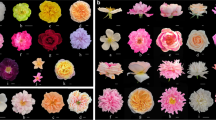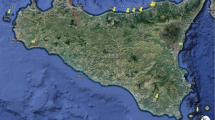Abstract
Rose (Rosa × hybrid L.) is one of the most important commercial ornamental crops cultivated worldwide for its beauty, fragrance and nutraceutical values. Characterization of rose germplasm provides precise information about the extent of diversity present among the cultivars. It also helps in cultivar identification, intellectual property right protection, variety improvement and genetic diversity conservation. In the present study, 109 Indian bred rose cultivars were characterized using 59 morphological and 48 SSR markers. Out of 48 SSRs used, 31 markers exhibited polymorphism and 96 alleles were identified with an average of 3.9 alleles per locus. Nei’s expected heterozygosity value of each locus ranged from 0.08 (with SSR ABRII/RPU32) to 0.78 (SSR Rh58). The similarity coefficient values ranged from 0.42 to 0.90 which indicated presence of moderated diversity among Indian cultivars. The neighbor-joining tree based on morphological data grouped the cultivars into two major clusters and several minor clusters based on their morphological resemblance. However, UPGMA dendrogram constructed using matching coefficient values grouped the cultivars into eight different clusters. Interpopulation analysis revealed higher genetic similarities between Hybrid Tea and Floribunda cultivars. An analysis for presence of population sub-structure grouped the Indian cultivars into eight different genetic groups. Analysis of molecular variance revealed apportioning of 97.59% of the variation to within subgroup diversity and 3.07% to between the cultivar groups. We have demonstrated here successful utilization of robust SSR to distinguish cultivars and assess genetic diversity among Indian bred rose cultivars. The information provided here is useful for cultivar identification and protection, cultivar improvement and genetic diversity conservation.




Similar content being viewed by others
References
Akond M, Jin S, Wang X (2012) Molecular characterization of selected wild species and miniature roses based on SSR markers. Sci Hortic 147:89–97
Azeem S, Khan AI, Awan FS, Riaz A, Bahadur S (2012) Genetic diversity of rose germplasm in Pakistan characterized by random amplified polymorphic DNA (RAPD) markers. Afr J Biotechnol 11(47):10650–10654
Beaumont MA, Nichols RA (1996) Evaluating loci for use in the genetic analysis of population structure. Proc R Soc Lond Biol Sci 263:1619–1626
Bendahmane M, Dubois A, Raymond O, Bris ML (2013) Genetics and genomics of flower initiation and development in roses. J Exp Bot 64:847–857
Ben-Meir H, Vainstein A (1994) Assessment of genetic relatedness in roses by DNA finger print analysis. Sci Hortic 58:158–164
Chen C, Durand E, Forbes F, Francois O (2007) Bayesian clustering algorithms ascertaining spatial population structure: a new computer program and a comparison study. Mol Ecol Resour 7(5):747–756
DeVries DP, Dubois LAM (1996) Rose breeding: past, present, prospects. Acta Hortic 424:241–248
Earl DA, VonHoldt BM (2012) Structure Harvester: a website and program for visualizing STRUCTURE output and implementing the Evanno method. Conserv Genet Resour 4(2):359–361
Esselink GD, Smulders MJM, Vosman B (2003) Identification of cut rose (Rosa hybrida) and rootstock varieties using robust sequence tagged microsatellite site markers. Theor Appl Genet 106:277–286
Esselink GD, Nybom H, Vosman B (2004) Assignment of allelic configuration in polyploids using the MAC-PR (microsatellite DNA allele counting-peak ratios) method. Theor Appl Genet 109:402–408
Evanno G, Regnaut S, Goudet J (2005) Detecting the number of clusters of individuals using the software structure: a simulation study. Mol Ecol 14:2611–2620
Excoffier L, Smouse PE, Quattro JM (1992) Analysis of molecular variance inferred from metric distance among DNA haplotypes: application to human mitochondrial DNA restriction data. Genetics 131:479–491
Flament I, Debonneville C, Furrer A (1993) Volatile constituents of roses: characterization of cultivars based on the headspace analysis of living flower emissions. In: Teranishi R, Buttery RG, Sugisawa H (eds) Bioactive Volatile Compounds from Plants. American Chemical Society, Washington DC, pp 269–281
Foucher F, Oyant HSL, Hamama L (2015) Towards the rose genome sequence and its use in research and breeding. Acta Hortic 1064:167–175
Grossi C, Raymond O, Boisson S, Jay M (1998) Rosa taxonomy and hierarchy of markers defined by ACT STATIS. J Chem Sci 54:25–34
Hubbard M, Kelly J, Rajapakse S, Abbott A, Ballard R (1992) Restriction fragment length polymorphisms in Rose and their use for cultivar identification. HortScience 27(2):172–173
Jiang L, Zang D (2018) Analysis of genetic relationship in Rosa rugosa using conserved DNA-derived polymorphism markers. Biotechnol Biotechnol Equip 32(1):88–94
Jowkar A, Mardi M, Kermani JKM, Kafi M, Pirseyedi SM, Mahmoodi P, Ghaffari MR, Fatahi R (2009) Isolation and characterization of microsatellite loci from Rosa pulverulenta. Mol Ecol Resour. https://doi.org/10.1111/j.1755-0998.2010.02898
Kaicker US (1992) Rose breeding in India and cytology of induced mutants of H.T.cv Folklore. Acta Hortic 320:105–112
Kim Y, Byrne DH (1996) Inter-specific hybrid verification of Rosa with isozymes. HortScience 31:1207–1209
Kimura T, Nishitani C, Iketani H, Ban Y, Yanamato Y (2006) Development of microsatellite markers in rose. Mol Ecol Recour 6(3):210–212
Koning-Boucoiran CFS, Esselink GD, Vukosavljev M, Westende WPC, Gitonga VW, Krens F, Voprrips RE et al (2015) Using RNA-Seq to assemble a rose transcriptome with more than 13,000 full-length expressed genes and to develop the WagRhSNP 68 k Axiom SNP array for rose (Rosa L.). Front Plant Sci 6:249
Kuhns LJ, Fretz TA (1978) Distinguishing rose cultivars by polyacrylamide gel electrophoresis isozyme variation among cultivars. J Am Soc Hortic Sci 103:509–516
Lewis WH (1957) Revision of the genus Rosa in Eastern North America: a review. Am Rose Annu 42:116–126
Liorzou M, Pernet A, Li S, Chastellier A, Thouroude T, Michel G, Malecot V et al (2016) Nineteenth-century French rose (Rose sp.) germplasm shows a shift over time from a European to an Asian genetic background. J Exp Bot 67(15):4711–4725
Lu M, An H, Li L, Jain M (2016) Genome survey sequencing for the characterization of the genetic background of Rosa roxburghii tratt and leaf ascorbate metabolism genes. PLoS ONE 11:147530
Marriott M (2003) Modern Roses (Post-1800). In: Roberts A, Debener T, Gudin S (eds) Encyclopedia of Rose Science, vol 1. Elsevier Science, Oxford, pp 402–409
Mikanagi Y, Saito N, Yokoi M, Tatsuzawa F (2000) Anthocyanins in flowers of genus Rosa sections Cinnamomeae (Rosa) Chinensis, Gallicanae and some modern garden roses. Biochem Syst Ecol 28:887–902
Mohapatra A, Rout GR (2005) Identification and analysis of genetic variation among rose cultivars using random amplified polymorphic DNA. Z Naturforsch 60:611–617
Murray M, Thompson WF (1980) Rapid isolation of high molecular weight plant DNA. Nucleic Acids Res 8:4321–4325
Nakamura N, Hirakawa H, Sato S, Otagaki S, Matsumoto S, Tabata S, Tanaka Y (2018) Genome structure of Rosa multiflora, a wild ancestor of cultivated roses. DNA Res 25(2):113–121
Nei M (1973) Analysis of gene diversity in subdivided populations. PNAS 70:3321–3323
Nybom H, Werlemark G, Esselink GD, Vosman B (2005) Sexual preferences linked to rose taxonomy and cytology. Acta Hortic 690:21–28
Oyant HSL, Crespel L, Rajapakse S, Zhang L, Foucher F (2008) Genetic linkage maps of rose constructed with new microsatellite markers and locating QTL controlling flowering traits. Tree Genet Genomes 4:11–23
Panwar S, Singh KP, Sonah H, Deshmukh PK, Namita B, Prasad KV, Sharma TR (2015) Molecular fingerprinting and assessment of genetic diversity in rose. Indian J Biotechnol 14:518–524
Prasad KV, Kumar S, Choudhary ML (2006) Molecular characterization of fragrant rose cultivars. Indian J Hortic 63:229–234
Pritchard JK, Stephens M, Donnelly P (2000) Inference of population structure using multilocus genotype data. Genetics 155:945–959
Qi W, Chen X, Fang P, Shi S, Li J, Liu X, Cao X, Zhao N, Hao H, Li Y, Han Y, Zhang Z (2018) Genomic and transcriptomic sequencing of Rosa hybrida provides microsatellite markers for breeding, flower trait improvement and taxonomy studies. BMC Plant Biol 18:119
Rai H, Raju DVS, Kumar AMB, Janakiram T, Namita S, Krishnan G, Rana JC (2015) Characterization and analysis of genetic diversity among different species of rose using morphological and molecular markers. Indian J Agric Sci 85(2):240–245
Riek JD, Cock KD, Smulders MJM, Nybom H (2013) AFLP-based population structure analysis as a means to validate the complex taxonomy of dog roses (Rosa section Caninae). Mol Phylogenet Evol 67(3):547–559
Rohlf FJ (2005) NTSYSpc (Numerical Taxonomy & Multivariate Analysis System). Version 2.2, Exeter Software, Applied Biostatistics Inc., New York
Rusanov K, Kovacheva N, Vosman B, Zhang L, Rajapakse S, Atanassov A, Atanassov I (2005) Microsatellite analysis of Rosa damascena Mill. Accessions reveals genetic similarity between genotypes used for rose oil production and old damask rose varieties. Theor Appl Genet 111:804–809
Smulders MJM, Esselink D, Voorrips RE, Vosman B (2009) Analysis of a database of DNA profiles of 734 hybrid tea rose varieties. Acta Hortic 836:169–174
Spillar M, Linde M, Oyant HSL, Tasi CJ, Byrne DH, Smulders MJM, Foucher F, Debener T (2011) Towards unweighted genetic map for diploid roses. Theor Appl Genet 122:489–500
Vainstein A, Ben-Meir H, Zucker A (1993) DNA fingerprinting as a reliable tool for the identification and genetic analysis of ornamentals. In: Proceedings of XVIIth eucarpia symposium on “creating genetic variation in ornamentals”, San Remo, pp 63–68
Walker CA, Werner DJ (1997) Isozyme and randomly amplified polymorphic DNA (RAPD) analyses of Cherokeerose and its putative hybrids ‘Silver Moon’ and ‘Anemone’. J Am Soc Hortic Sci 122:659–664
Yan Z, Denneboom C, Hattendorf A, Dolstra O, Debener T, Stam P, Visser PB (2005) Construction of an integrated map of rose with AFLP, SSR, PK, RGA, RFLP, SCAR and morphological markers. Theor Appl Genet 110:766–777
Yang S, Guo N, Hong GE (2016) Morphological and AFLP based genetic diversity in Rosa platycantha population in Eastern Tianshan Mountains of northwestern China. Hortic Plant J 2(1):55–60
Yeh FC, Yang RC, Boyle TBJ, Ye ZH, Mao JX (1997) POPGENE, the user-friendly shareware for population genetic analysis. Molecular Biology and Biotechnology Centre, University of Alberta, Canada
Yeh FC, Yang RC, Boyle T (1999) Power Marker 3.23, Alpha Ease FC 4: Microsoft Window-based free Software for Population Genetic Analysis. ftp.microsoft.com/Softlib/HPGL.EXE
Zhang LH, Byrne DH, Ballard RE, Rajapakse S (2006) Microsatellite marker development in rose and its application in tetraploid mapping. J Am Soc Hortic Sci 131(3):380–387
Zlesak DC (2006) Rosa x hybrida L. In: Anderson NO (ed) Flower Breeding and genetics: issues, challenges and opportunities for the 21st century. Springer, Dordrecht, pp 695–738
Acknowledgements
The authors thank the Indian Council of Agricultural Research for the fellowship to the first author (AV) and for the facilities provided for conducting this work. The views expressed in this article are authors own and do not reflect the official position of the Indian Council of Agricultural Research.
Author information
Authors and Affiliations
Corresponding author
Additional information
Publisher's Note
Springer Nature remains neutral with regard to jurisdictional claims in published maps and institutional affiliations.
Electronic supplementary material
Below is the link to the electronic supplementary material.
Rights and permissions
About this article
Cite this article
Veluru, A., Bhat, K.V., Raju, D.V.S. et al. Characterization of Indian bred rose cultivars using morphological and molecular markers for conservation and sustainable management. Physiol Mol Biol Plants 26, 95–106 (2020). https://doi.org/10.1007/s12298-019-00735-8
Received:
Revised:
Accepted:
Published:
Issue Date:
DOI: https://doi.org/10.1007/s12298-019-00735-8




